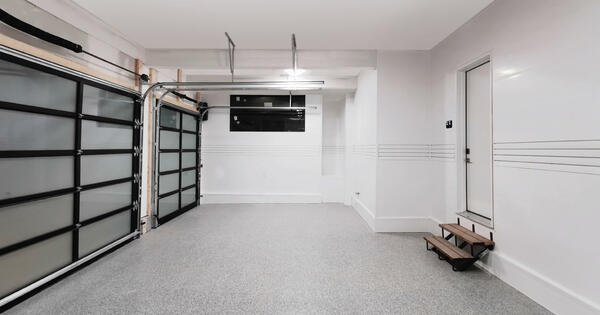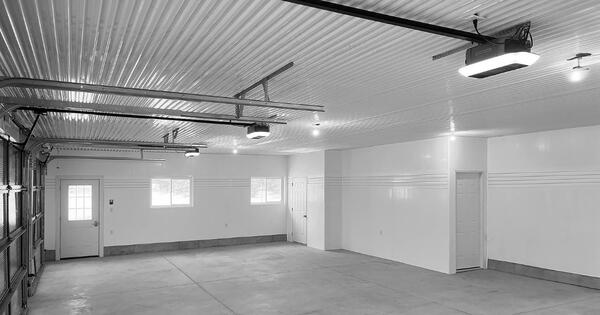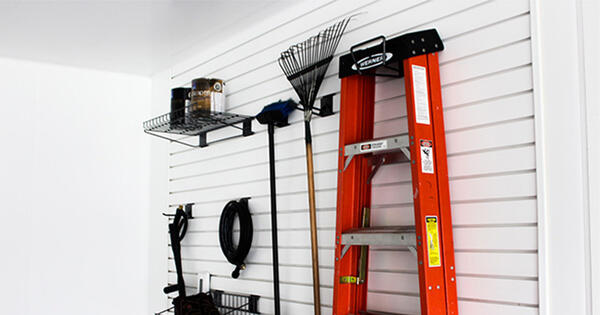Have you ever wondered exactly how big your 3-car garage is? Knowing the square footage is useful for planning renovations, organizing your storage, or even when you're buying a new home. Here's how to figure it out.
Why It's Important to Know Your Garage's Square Footage
Understanding your garage's square footage is practical for several reasons:
- Maximizing Space: When you know the exact square footage of your garage, you can plan the layout more effectively. This knowledge allows you to strategically place vehicles, tools, and storage units in a way that maximizes the available space. For instance, you can determine whether there's enough room to add a workbench, install overhead storage racks, or even park an additional vehicle like a motorcycle or ATV. Knowing your garage's dimensions can also help you avoid clutter and make the most of every square foot, ensuring that your garage remains functional and organized.
- Planning Renovations: Whether you're considering a minor upgrade or a major renovation, accurate measurements are crucial. Knowing the square footage allows you to design upgrades or expansions with precision. For example, if you’re planning to replace existing drywall with a more durable and moisture-resistant material like Trusscore Wall&CeilingBoard, you’ll need to know the exact area you’re working with to order the right amount of materials. Additionally, if you’re thinking about expanding the garage to accommodate larger vehicles or create additional storage, understanding the current square footage helps you plan the scope and scale of the project more accurately.
- Estimating Storage Capacity: Your garage isn’t just a place to park cars — it’s also a valuable storage area. By knowing the square footage, you can assess how much storage capacity you have and make informed decisions about what can be stored there. For example, if you have seasonal items like holiday decorations, lawn equipment, or sports gear, understanding the garage's capacity can help you determine how much space these items will occupy and whether you need additional storage solutions. This knowledge prevents overcrowding and helps maintain a clean, organized space.
- Meeting Building Codes: Local building codes often have specific requirements regarding the size and structure of garages. Whether you’re building a new garage or modifying an existing one, accurate dimensions are essential to ensure compliance with these regulations. Failing to meet building code requirements can lead to fines, delays, and potential legal issues down the line. By knowing your garage’s square footage, you can ensure that any changes you make are up to code, protecting your investment and avoiding unnecessary complications.



Standard Sizes for a 3-Car Garage
While dimensions can vary, most 3-car garages fall within a certain size range:
- Common Dimensions: A standard 3-car garage typically ranges between 30 x 20 feet and 36 x 24 feet. These dimensions provide enough room to comfortably park three average-sized vehicles while still leaving space for additional storage or a small workspace. The exact size you need will depend on the size of your vehicles and how much additional space you want for storage or other purposes.
- Variations: While the standard dimensions are a good starting point, it’s important to remember that they can vary depending on the architectural design of the home and the specific needs of the homeowner. For instance, if you own larger vehicles like trucks or SUVs, you may require a larger garage with more depth and width to accommodate them. Alternatively, if you plan to use the garage as a workshop or for extensive storage, you might prefer a larger space to allow for more flexibility and comfort.
- Ceiling Height: In addition to the length and width of the garage, ceiling height is another important dimension to consider. Standard garage ceilings typically range between 8 and 12 feet. A higher ceiling can provide additional vertical storage options, such as overhead racks or lofts, which can be particularly useful in maximizing the available space. Additionally, if you plan to install a car lift for vehicle maintenance or storage, a higher ceiling will be necessary to accommodate the equipment.
Tools You Need to Measure Your 3-Car Garage
Accurate measurements are the foundation of any successful project, whether you’re planning a renovation or simply organizing your garage. To ensure you get precise measurements, gather the following tools:
- Measuring Tape: A long, durable measuring tape is essential for capturing the dimensions of your garage. Ideally, you should use a tape that’s at least 30 feet long, as this will allow you to measure the length and width of your garage without needing to reposition the tape multiple times.
- Notepad and Pen: As you take measurements, it’s important to document them accurately. Keeping a notebook and pen or pencil handy ensures that you don’t overlook any details. You can also use this space to jot down notes about any obstacles or irregularities that may affect your measurements.
- Calculator: A calculator is useful for performing quick computations, especially when determining the total square footage of your garage. It’s a simple tool, but it can help you avoid errors and ensure that your calculations are accurate.
- Laser Distance Measurer (Optional): For those who want the most precise measurements possible, a laser distance measurer is a great tool. These devices can provide highly accurate measurements, especially in larger or irregularly shaped spaces where a traditional tape measure might be less effective.
Step-by-Step Guide to Measuring Your Garage
Measuring your garage is a straightforward process, but it requires attention to detail to ensure accuracy. Follow these steps to determine your garage's dimensions:
- Measure the Length: Start by measuring the length of your garage. Place the measuring tape at the interior front wall and extend it to the back wall at floor level. This will give you the most accurate measurement, as garages can sometimes have slight variations in wall height that can affect the overall dimensions.
- Measure the Width: Next, measure the width of the garage by extending the tape from one side wall to the other, again at floor level. Be sure to measure the widest part of the garage, as this will give you the most accurate representation of the available space.
- Multiple Measurements for Accuracy: For best results, take multiple measurements along both the length and width of the garage. This helps account for any irregularities in the walls or floor that could affect the overall dimensions. If there are significant discrepancies between your measurements, use the largest ones to ensure that you’re capturing the full extent of the space.
- Record Everything: Make sure to document all your measurements and any notes on obstacles or unusual features.



How to Calculate the Square Footage of a 3-Car Garage
Once you have your measurements, calculating the square footage of your garage is a simple process:
- The Basic Formula: The basic formula for calculating square footage is Length x Width. This will give you the total area of your garage in square feet.
- Example: If your garage measures 32 feet in length and 24 feet in width, the calculation would be: 32 ft x 24 ft = 768 square feet.
- Double-Check: It’s always a good idea to double-check your calculations to ensure accuracy. Even small errors in measurement can lead to significant discrepancies in the total square footage. If you’re unsure about your results, consider remeasuring the garage to verify your numbers.
Dealing with Irregularly Shaped Garages
Not all garages are perfect rectangles. If your garage has an irregular shape, you’ll need to take a slightly different approach to calculate the square footage:
- Segment the Space: Divide the garage into smaller, more manageable sections. For example, if your garage has an L-shape, you can break it down into two rectangles or squares.
- Measure Individually: Measure the length and width of each section separately. Be sure to record these measurements accurately, as they will form the basis of your calculations.
- Calculate Each Area: Apply the Length x Width formula to each individual section. This will give you the square footage for each part of the garage.
- Aggregate the Totals: Add the square footage of all the sections together to get the overall square footage of the garage. This method ensures that you account for all parts of the space accurately, even if the garage has an unusual shape.
Accounting for Usable Space
It’s important to remember that not all of the square footage in your garage may be usable. To get a more accurate sense of how much space you have available for parking, storage, or other activities, you’ll need to account for any non-usable areas:
- Identify Non-Usable Areas: Look for areas taken up by fixed features like shelves or support beams.
- Adjust Accordingly: Subtract these areas from the total square footage. For example, if a workbench takes up 15 square feet in a 768-square-foot garage, the usable space is 753 square feet.
- Consider Ceiling Height: If you're planning vertical storage, make sure the ceiling height is suitable.
Avoiding Common Measuring Mistakes
Even small mistakes can lead to inaccurate measurements, which can cause problems down the line. Here are some common pitfalls to avoid:
- Incomplete Measurements: Always measure to the garage’s widest and longest points to ensure you capture the full dimensions of the space.
- Overlooking Recesses: Be sure to include any alcoves, niches, or recessed areas in your calculations. These small spaces can add up and significantly affect the total square footage.
- Neglecting Obstacles: Don’t forget to account for any obstacles or structural elements that might impede space, such as support columns or built-in features.
- Rushing the Process: Take your time when measuring to ensure precision. Rushing through the process can lead to errors that may be difficult to correct later.
Use Your Measurements to Complete a Takeoff in the Trusscore Cost & Materials Estimator
If you’re planning to outfit your 3-car garage in Trusscore Wall&CeilingBoard and Trusscore SlatWall, you can plug your measurements into the Trusscore Cost & Materials Estimator to get a detailed material estimate and a ballpark project price.We recommend measuring the length, width, and height of the walls in your room. Measure the height and width of any garage doors, too.
Note: Length should be measured across the ceiling joists, width is parallel to ceiling joists.
When you’re done, enter the custom dimensions of your space into the Cost & Materials Estimator, and we’ll generate a detailed list of required materials for you to take to your local Trusscore retailer to get an accurate price.

Accurately measuring your 2-car garage's square footage can make a big difference in how you utilize the space. From planning renovations to optimizing storage, the benefits are clear. So, grab your measuring tape and get started — understanding your garage’s dimensions can help you make the most of every square foot.






